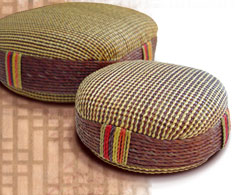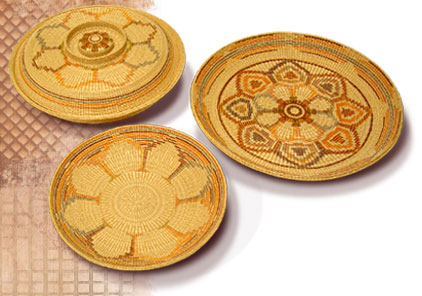Yi Sang-jae, Master Craftsman of Wancho Weaving, was born on the tiny island of Gyodong-myeon, famous for its beautiful sunsets. It was a village tradition to weave wancho goods for additional income when the farmers’ fields lay fallow. His family was not an exception, and his grandfather and mother were particularly skilled at wancho weaving. Their works were so good that a missionary priest from the Anglican Church in Britain bought several of their pieces to take back home. In such an environment it was natural that most of the children on Gyodong-myeon were introduced to the art of wancho weaving at an early age to learn patience and basic skills. For Yi, after he graduated from elementary school he began to help his family for whom wancho weaving was a great source of additional income. difficult to conform and thus tried to find his own way. Not surprisingly, the process became much easier once he developed his own unique techniques and style. Gradually, he started to win prizes in various craft contests held at the province level. In 1994, he won the Bronze Prize in the National Craft Contest when he entered a wancho tea table and other small items. However, his most glorious moment came in May 1996 when he was given the title of Wancho Jang, or Master Craftsman of Wancho Weaving, and the Korean government designated his works of art as “Important Intangible Cultural Property No. 103.” It was probably the greatest honor and achievement an artist of traditional crafts could have in Korea, but for him, he said, his happiest moment was in 1970 when he first met a woman named Yu Seon-ok. Yu was his pupil, but soon they fell in love and married. Even today, his wife is his faithful head pupil and most trusted and loved companion. For his wife, the long and hard training session under her strict tutor husband paid off when she entered a wancho tea set into the 2000 National Craft Contest and won the President’s Prize, the highest honor. It was a situation that ancient Koreans captured in an idiom that translates into: “Indigo came from blue, but bluer than blue.” After three decades of being together, Yi and Yu are now the most successful tutor and pupil duo in Korea. But first and foremost, they are the happiest couple in the world. “When I heard,” Yi said, looking at his wife with loving eyes, “that my art was designated as an Intangible Cultural Property, I was so delighted that the decades of hard work were not meaningless after all. I felt particularly grateful to my wife because she had been, and is, always by my side even when I was having a most difficult time." View the master's works |
|||||||||||
|



















